Xuan Thuy National Park, Nam Dinh, Vietnam 8-10 December 2019 Callyn Yorke
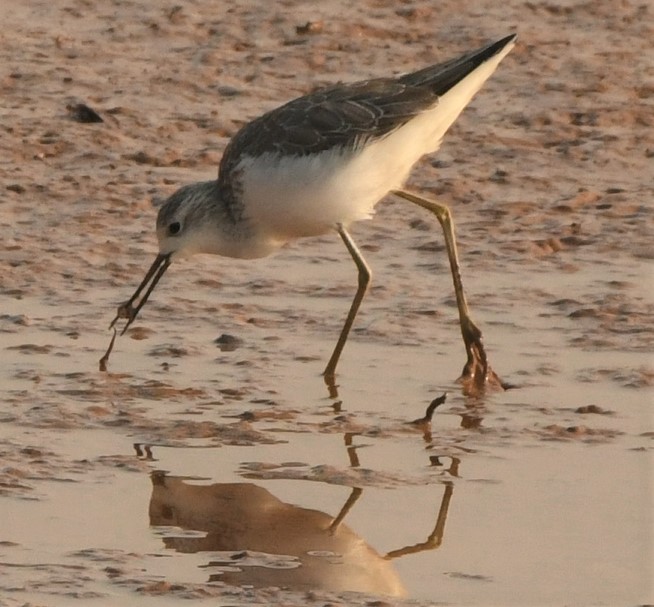
Da Thao and I hired a driver for 1.8 million VND ($78 US) through the Golden Rice Hotel, Hanoi. The young Vietnamese driver reassured Thao that, despite having never been there, he could take us directly to Xuan Thuy National Park. Khong co chi, baby (no problem). But we were soon lost somewhere outside the Hanoi city limits. And, from what I could gather from a National Geographic Adventure Travel Map of Vietnam North, we were pretty much off course for the remainder of the journey. Connecting Hanoi to the coast was a navigational nightmare of unmarked roads, towns and villages. Furthermore, the closer we got to the sea, the more confusing the route became; GPS was progressively useless. The Xuan Thuy Nature Reserve (a segment of the vast Red River Delta) includes a maze of unnamed roads running through villages, mangroves and aquaculture farms.

When we were relatively close to the park, approaching from the south on a narrow sea wall drive, there appeared in the distance a huge section of missing pavement and a construction crew pouring concrete into it. Without space to turn the car around, this was apparently the end of the line for us. Locals may have known the correct detours but the few we had hailed for directions had not been to the park headquarters; some of those folks may not have known they were actually living in a national park. No one at the park had answered our phone calls from Hanoi. We were unsure the park was even open. In fact, we had no idea where the park entrance was. We were on our own and eventually became entirely dependent on local residents for assistance. While we were stranded at the road construction site, only about two kilometers from the park entrance, a local villager approached on his motorbike and offered his services.

The three of us and our belongings arrived at the main gate of the park headquarters a few minutes later. We gave the Vietnamese man a few dollars for transport on his rusty little motorbike, which had been overloaded nearly to the point of terminal metal fatigue. The three-hour journey from Hanoi had taken us about five. Thao, who has struggled with motion sickness her entire life, had used up the last of her plastic bags. It came as some relief to know that, mostly by blind luck, we had made it safely to the official entrance of Xuan Thuy National Park.
A two-story park lodge, looking a bit weathered and bordered by an overgrown garden, was largely vacant. We checked into a room on the upper level with a wooden door that stubbornly refused to open more than half way, objecting loudly as it scraped its bottom on the tile floor.
There was good news: The room was cheap ($8.75/night) clean, quiet and conveniently located near the cafeteria and garden birding areas. Wifi, a large electric fan and mosquito netting, were included. Only two other guests (a birder from San Jose, California and his Vietnamese guide) occupied the 16-room lodge.

Thuan, the park manager, who apparently lived alone with his big-screen TV in a guard shack at the front gate, was friendly and extremely helpful. He arranged for motorbike rentals ($9/day – each) and retained the services of a local park guide, Trung, for a day-trip birding the mangroves and some offshore islands ($20/day for Trung, $65 for the boat).

The other news: Our room (#9) was without a heater (December nights and mornings can be quite chilly in Xuan Thuy). A concrete and tile bathroom featured a wall-mounted shower hose that was wedged awkwardly between the sink and the toilet, resulting in a daily Olympic aquatics event. The park cafeteria and most of the facilities were closed for the winter (presumably the same applied during the summer); the nearest place for a meal was a 15-minute stroll to a local village (Cafe Hiep Duc) specializing in basic noodle soup (pho), 333 Beer, and very little else (about $5 each per meal).
That afternoon, our stamina fading with the daylight, we politely accepted an invitation for another threesome motorbike adventure. Thuan had a shiny new Honda scooter and appeared to have little on his agenda aside from watching TV. We set off on a paved road, first bisecting aquaculture ponds then mangrove-mudflats, extending for about three kilometers south of the park headquarters. This levee was essentially the main street and provided an elevated view some of the best birding areas in the park, bordering tidal mudflats and mangrove forest. We drove slowly, stopping frequently to observe waterbirds, including scattered small flocks of Marsh Sandpiper, Common Redshank and an occasional Common Greenshank.

Suddenly, Thuan stopped at the side of the road and began pointing excitedly toward the mangroves. We scanned the horizon with our binoculars. Three Black-faced Spoonbill were flying away gracefully in silence. I fumbled with my camera for a few seconds and snapped a couple of recognizable images of this rare and endangered species, evidently surviving as a viable population in the park. Thuan smiled with pride, having just showed two newly arrived birders one of the most sought after species in Southeast Asia. This was definitely a highlight of our trip to the northern provinces of Vietnam.
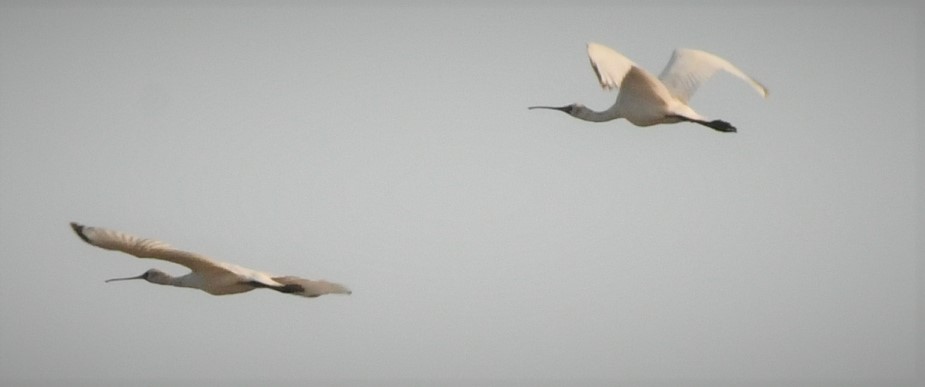
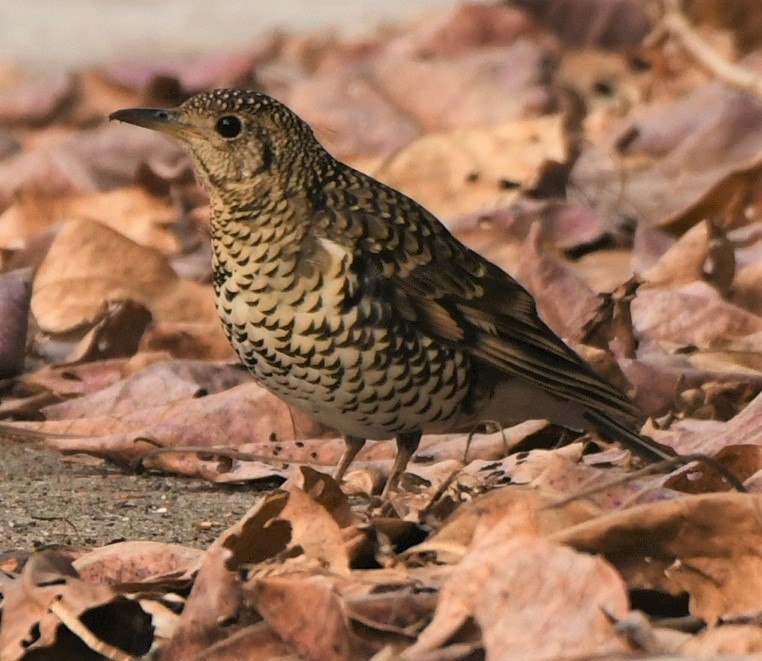
Some of the best birding we found was at the park headquarters. A mosaic of Casuarina woodland and coastal scrub in various stages of regrowth was bordered by ornamental plantings. Abundant vegetation provided cover for a good variety of birds, including Oriental Turtle Dove, White’s Thrush, Northern Sooty-headed Bulbul, Daurian Redstart, and Pallas’ Leaf Warbler. The walled-in grounds included a large (perhaps 0.5 hectare), concrete-lined pond and two island gardens, bisected by a walkway and gazebo; the latter structure was a convenient hide for observing and photographing waterbirds, e.g. Common and Pied Kingfisher. Dusk was punctuated by the arrival of scores of Chinese Pond Heron roosting in the Casuarina trees.
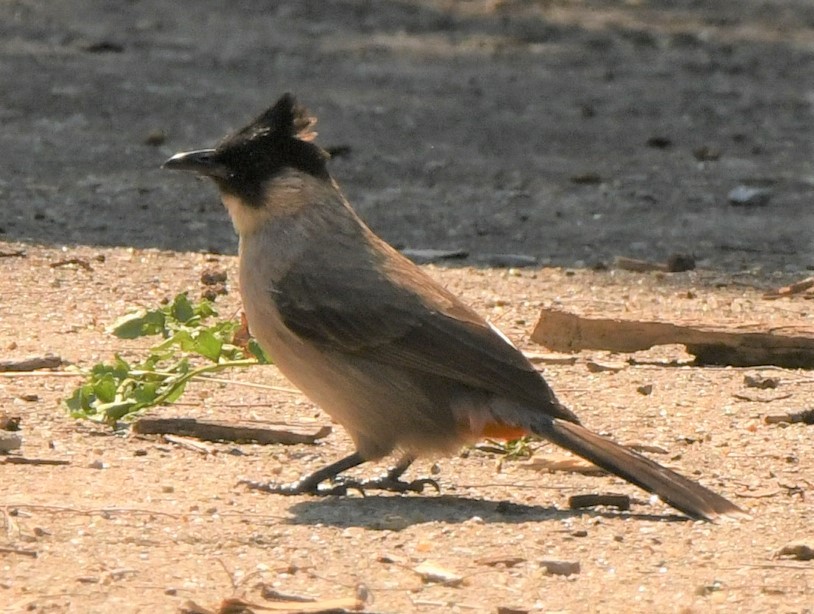
We learned a little too late in our visit that a bird feeding and watering station behind the lodge had been activated by a visiting Vietnamese bird guide.
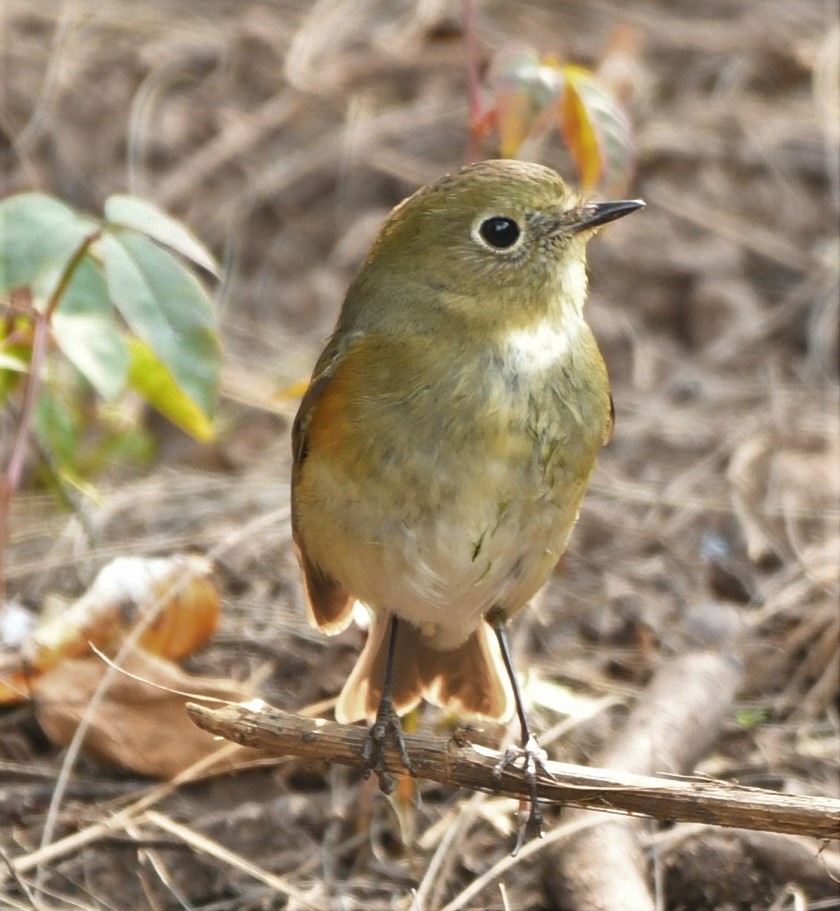
An Orange-flanked Bush Robin and a Cyornis sp. were hanging out in that area the morning we checked out of the lodge.
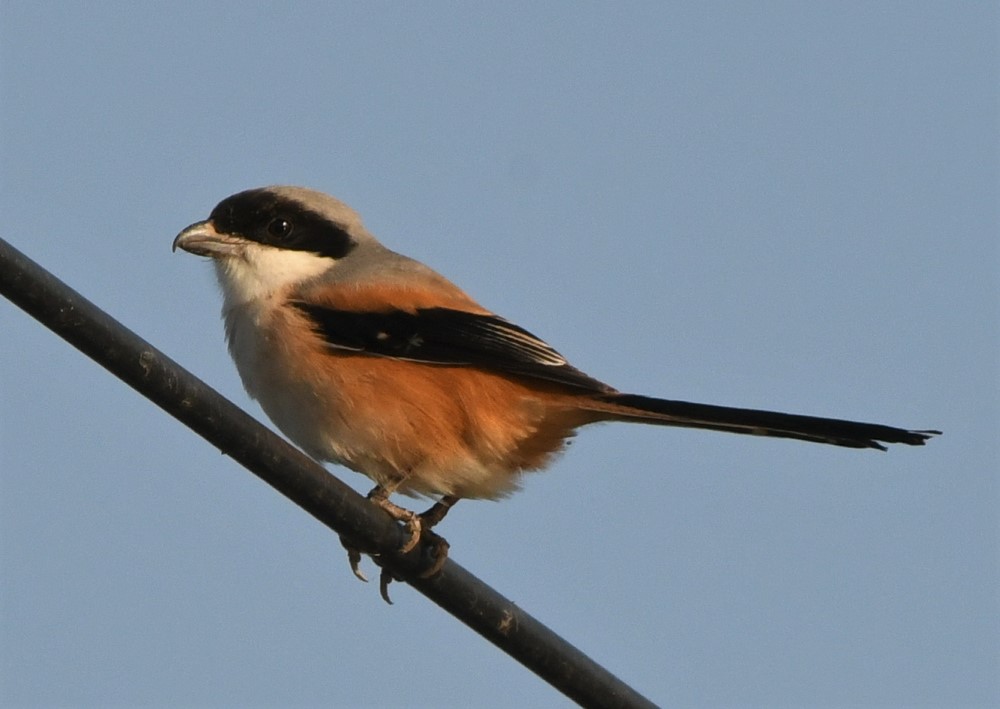
Our final full-day in the park was productive and included a boat trip to an offshore island for the main purpose of observing shorebirds. Although the mangroves and mudflats supported a variety of waders, for some reason, this assemblage did not include many of the smaller species, such as plovers and sandpipers. Those birds appeared to be largely confined to relatively undisturbed islands offshore.

The boat rental arrangement had been made by Trung, who assured us we could land on one of the islands and study the birds at close range. That sounded perfect. I fastened the tripod to my waterproof backpack and wrapped up the spotting scope inside. But when we arrived at the boat launch, it was announced that the regular (small) boat for the trip was unavailable.

Instead, we would have to hire a full-sized, 15-meter long river boat for an additional fee of about $50. Nevertheless, the big party boat appeared seaworthy and with increasing winds, could possibly offer greater stability for making observations. No one mentioned that the vessel was too large to land on the shallow islands. That fact became irritatingly obvious about forty minutes later as we approached an island where small flocks of shorebirds could be seen.
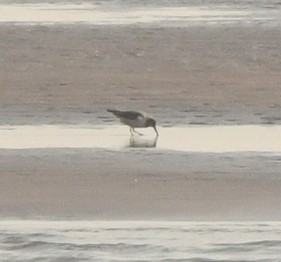
As onshore winds built up, so did the seas and once we were outside of the relatively protected mangrove channel, the boat was rolling and pitching wildly. We approached a large, flat, sandy island where shallows prevented us from getting any closer to the shore than about 0.5 km. Trung set up his tripod and scope on the upper deck. Unfortunately, there was too much boat movement to see anything definitive. A 10x Zeiss binocular was likewise unable to resolve more than general shapes, i.e. distinguish between large and small shorebirds. Most useful, however, was a Nikon D850 coupled with a 200-500 mm lens. Images obtained of distant birds could be magnified and in some cases clinch specific identities, e.g. Little Ringed Plover and Broad-billed Sandpiper, apparently two of the most abundant birds on the island. Nothing resembling a rarity such as Spoon-billed Sandpiper or Asian Dowitcher, could be positively identified. No gulls or terns were seen here or anywhere else in Xuan Thuy. Overall, considering the cost and our limited time schedule, the boat trip was underwhelming.


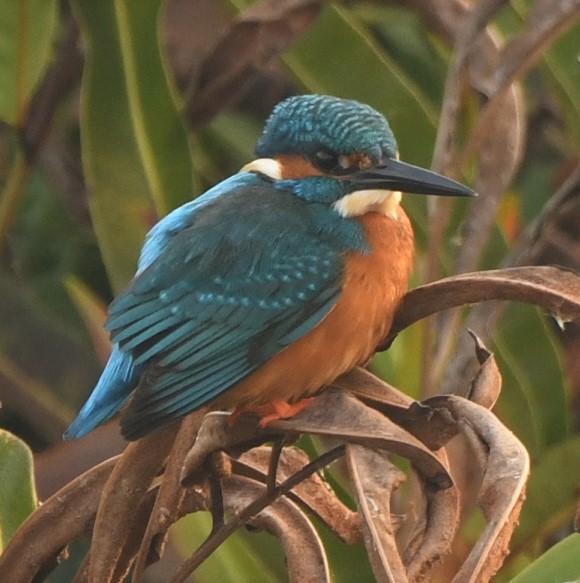
By the time we checked out at 1030 hrs. on December 10, 2019, our bird list had topped out at fifty-five species. Twenty-six species (47%) were waterbirds, i.e. those dependent on aquatic resources. Herons and egrets were well represented (9 species), together with about the same number of Charadrids (i.e. plovers and sandpipers, 9 species). Landbirds, including eight migratory species that were probably overwintering in the park, comprised the remainder. But since new bird species were added with each of our surveys, it is likely that our trip list (see below) would have been considerably larger had we stayed for an additional few days.

ANNOTATED BIRD LIST OF XUAN THUY NATIONAL PARK
8-10 December, 2019 Callyn Yorke
KEY
Location abbreviations: (PHQ) Park headquarters, including paved walkways, gardens, casuarinas, coastal scrub, and pond; (MM) Mangroves, tidal channels and mudflats; (AQ) Aquaculture ponds & small lakes with marsh borders; (HGF) Homesteads, small gardens and fields; (OI) Offshore island, i.e. seen during the December 9, 2019 boat trip.
Other details: Numbers following each species entry represent the highest single survey count; sex and age (when known), m = male, f = female; ad = adult, imm = immature; In flight = fly; height above ground (m) = agl. Gregarious = greg.; Vocalizations (calls and or song) = vocal.
Systematics and nomenclature largely follow Birdlife International, Checklist of The Birds of the World (2018).
BIRDS NOTED
- Northern Shoveler (Spatula clypeata) 50 (f; m – eclipse plmg.) greg., dabbling at one location only, a large lake, AQ.
- Eurasian Teal (Anas crecca) 3 (f), greg., MM.
- Little Grebe (Tachybaptus ruficollis) 5 loosely greg., in same lake as NOSH, AQ.
- Feral Rock Pigeon (Columba livia) 10 greg. in dense housing areas, HGF.
- Red Turtle Dove (Streptopelia tranquebarica) 4 on utility wire, greg. PHQ (photo).
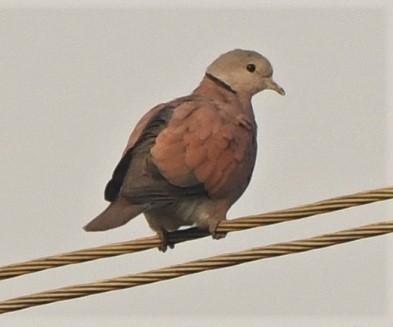
- Oriental Turtle Dove (Streptopelia orientalis) 4 on utility wire with RTDO, greg. PHQ (photo).
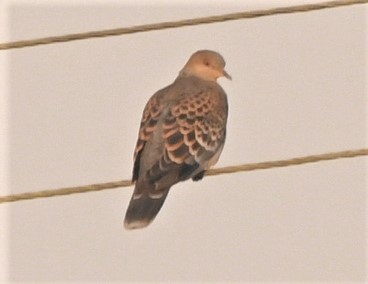
- Eastern Spotted Dove (Spilopelia chinensis) 20 greg. PHQ, HGF.
- Himalayan Swiftlet (Aerodramus brevirostris) 1 ID: similar in size, proportions and flight with Germain’s Swiftlet but lacking a pale rump patch, PHQ.
- Greater Coucal (Centropus sinensis) 3 active in tall weedy overgrowth, early morning and late evening, PHQ, HGF, AQ.
- White-breasted Waterhen (Amaurornis phoenicurus) 2 in overgrown weeds at edge of pond, PHQ; MM (photo).
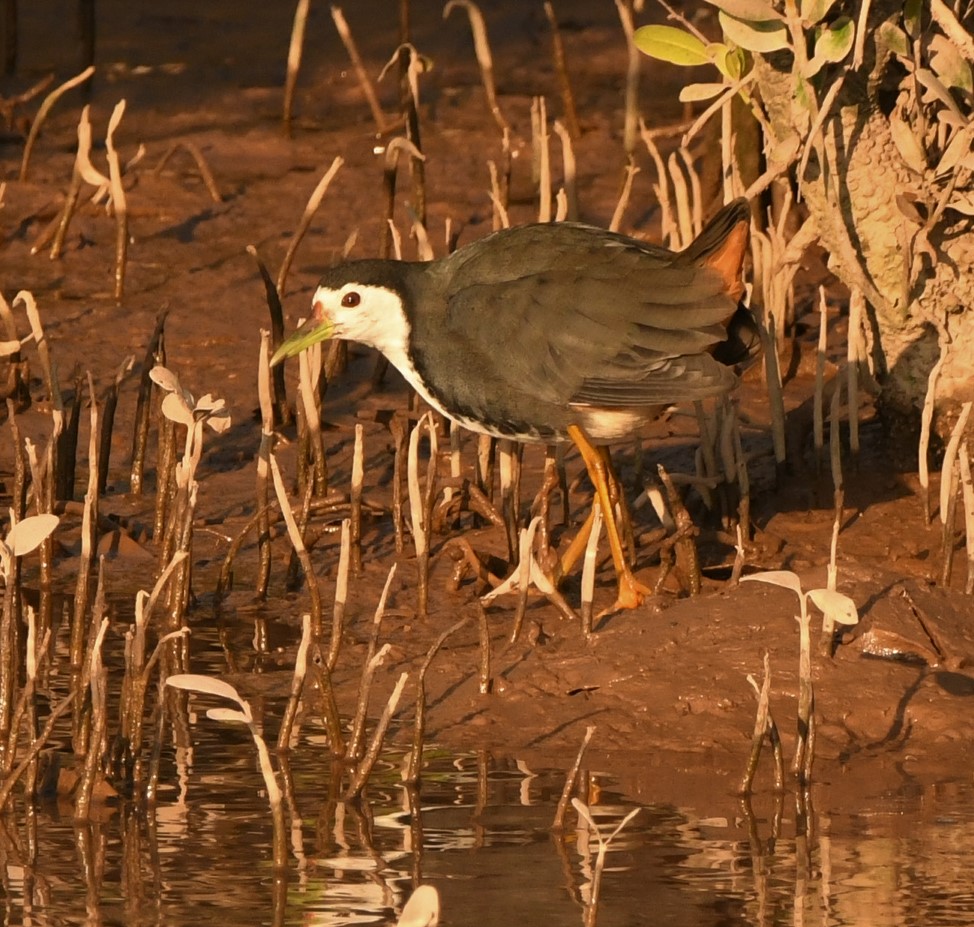
- Common Moorhen (Gallinula chloropus) 1 at edge of marsh, AQ.
- Black-faced Spoonbill (Platalea minor) 20 a large roost in the mangrove forest; pairs and trios flying over the levee road about 1 km south of the PHQ, MM (photo).
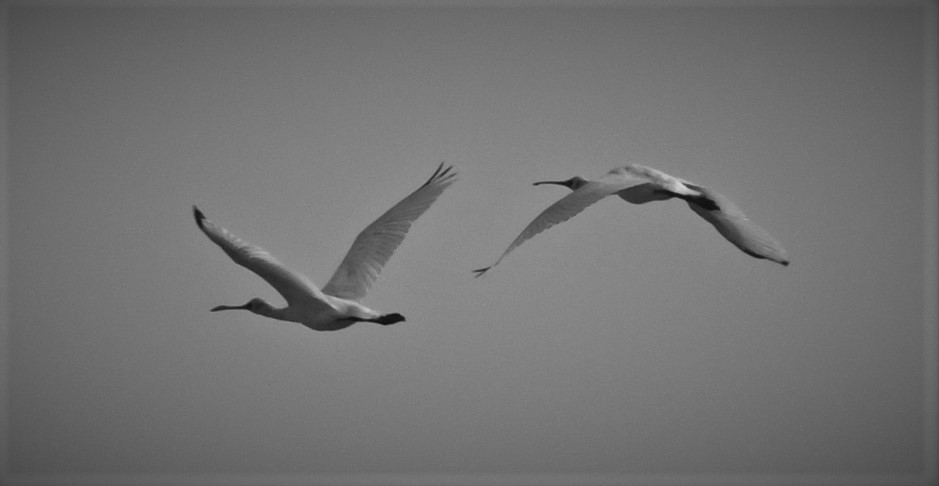
- Black-crowned Night Heron (Nycticorax nycticorax) 1 at edge of mangrove near observation tower, MM.
- Striated Heron (Butorides striata) 1 at edge of channel, MM.
- Chinese Pond Heron (Ardeola bacchus) 100 + (ad, imm) ubiquitous, greg., large overnight roost in casuarinas at PHQ (photo).

- Gray Heron (Ardea cinerea) 3 individuals on mudflats and in shallow channels, MM (photo).

- Purple Heron (Ardea purpurea) 1 in shallows of lake, AQ.
- Eastern Great Egret (Ardea modesta) 5 ubiquitous in wetlands, often seen in flight.
- Intermediate Egret (Ardea intermedia) 5 greg, MM, AQ.
- Little Egret (Egretta garzetta) 20 greg, ubiquitous in wetlands.
- Pacific Golden Plover (Pluvialis fulva) 2 greg. foraging on mudflats, MM (photo).
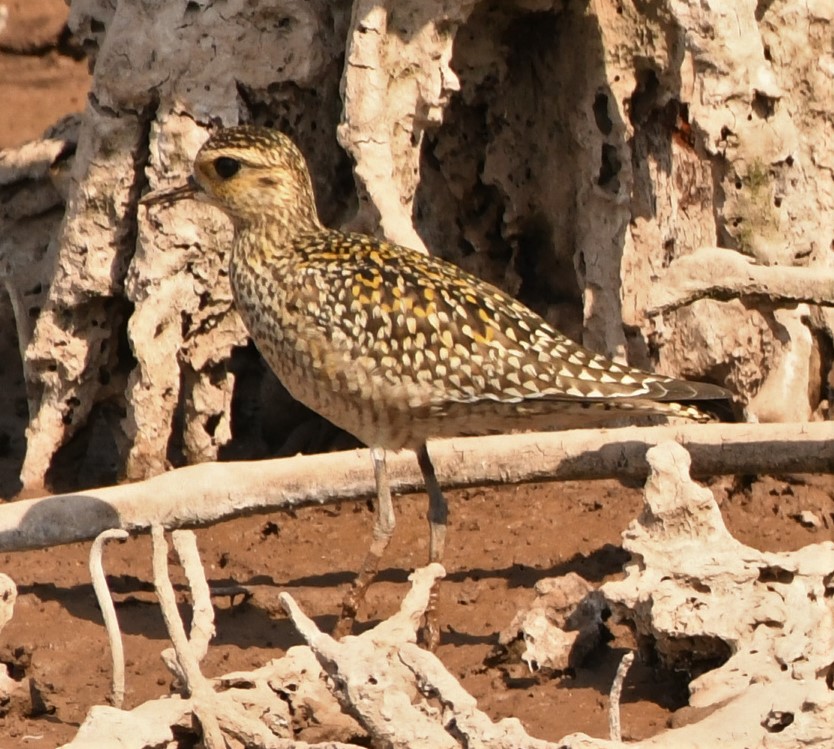
- Little Ringed Plover (Charadrius dubius) 5 loosely greg. on shore and wet sand, OI.
- Kentish Plover (Charardrius alexandrinus) 8 loosely greg. on shore and wet sand, OI.
- Broad-billed Sandpiper (Calidris falcinellus) 20 greg. resting inland; a few foraging on shore, OI (photo – see introductory text).
- Sanderling (Calidris alba) 3 ID appeared from the distance to be an all white, medium-small sized peep, resting with a flock of BBSA inland, OI.
- Common Sandpiper (Actitis hypoleucos) 1 foraging at edge of concrete pond; mudflats, PHG, MM (photo).
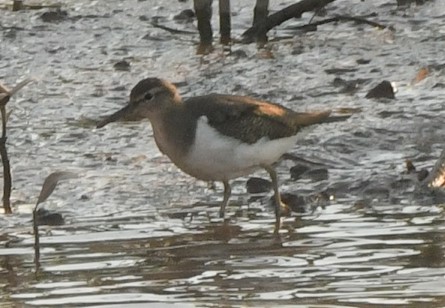
- Common Greenshank (Tringa nebularia) 2 individuals foraging/resting in shallows, MM (photo).
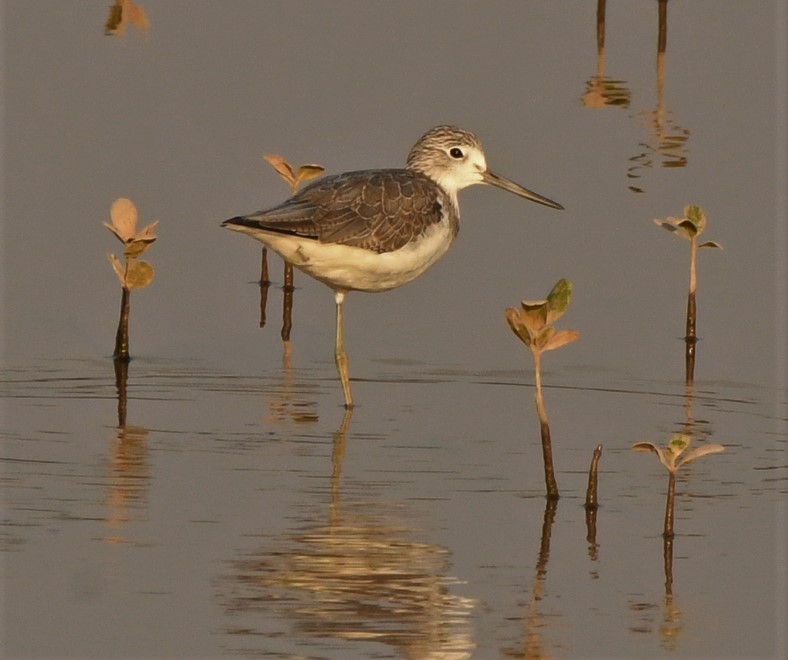
- Common Redshank (Tringa totanus) 2 ID (c.f. SPRE): relatively stout, compact body; relatively short thick bill; white supercilium intersecting eyering; loosely gregarious, often foraging on mudflats and in shallows with MASA, MM (photo).
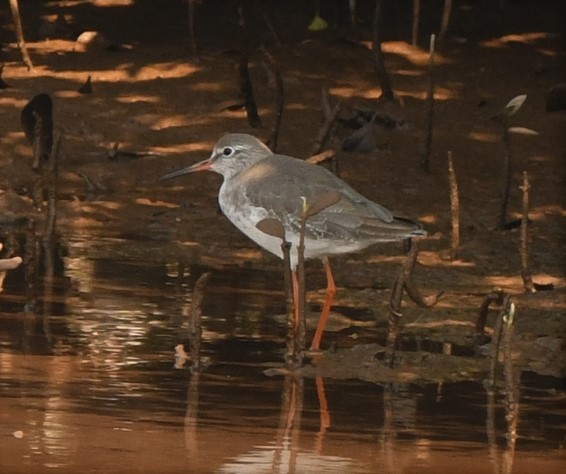
- Marsh Sandpiper (Tringa stagnatilis) 25 greg. in shallows and on mudflats, MM (photo).
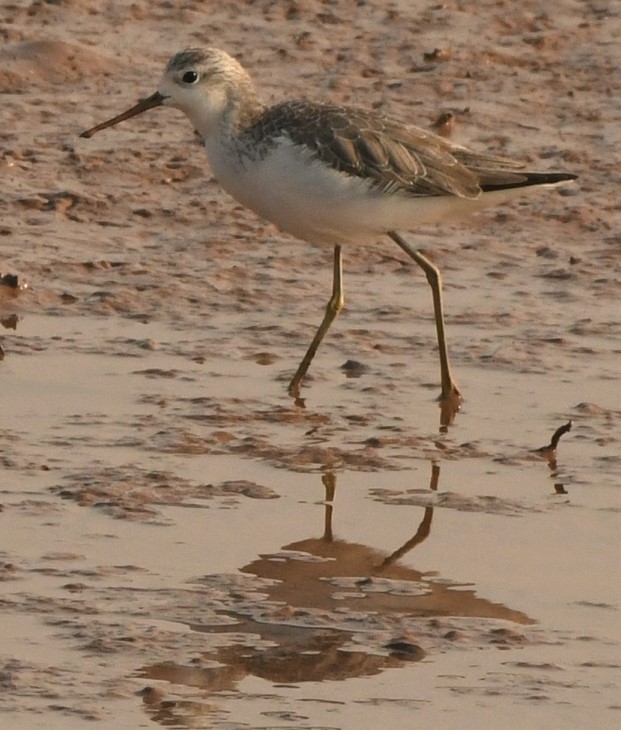
- Black-winged Kite (Elanus caeruleus) 1 hovering above fallow field, AQ.
- Eastern Marsh Harrier (Circus spilonotus) 1 (f) hovering and diving in coastal scrub, AQ/MM (photo – see introductory text).
- Common Kingfisher (Alcedo atthis) 4 solitary, ubiquitous on low perch near water(photo).
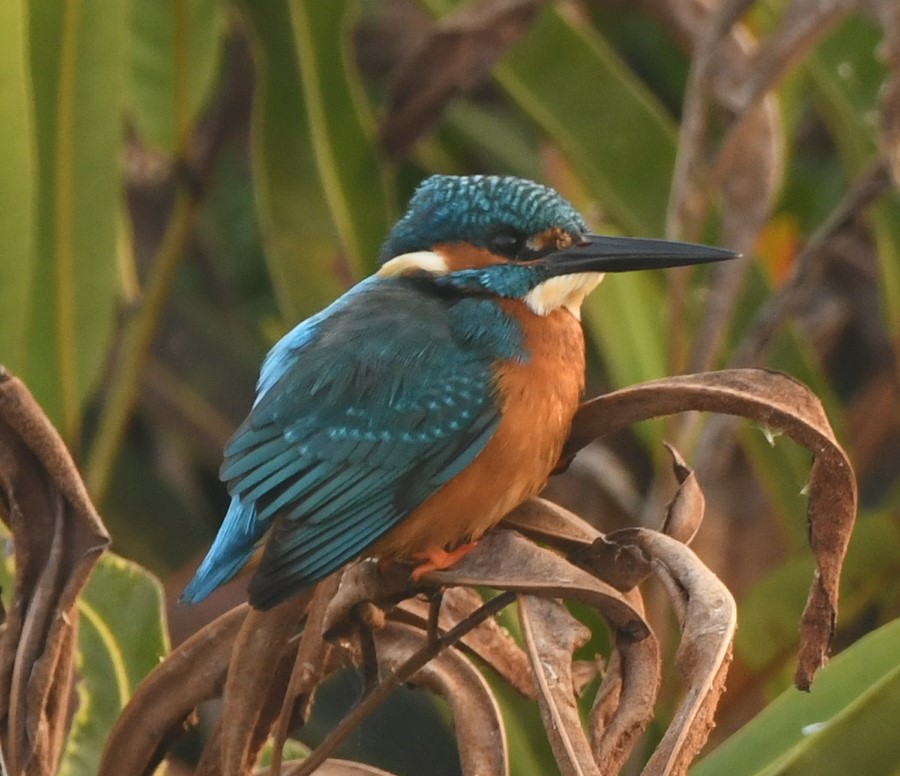
- Pied Kingfisher (Ceryle rudis) 1 hovering above and diving into channel, MM; flying low over pond, PHQ (photo).
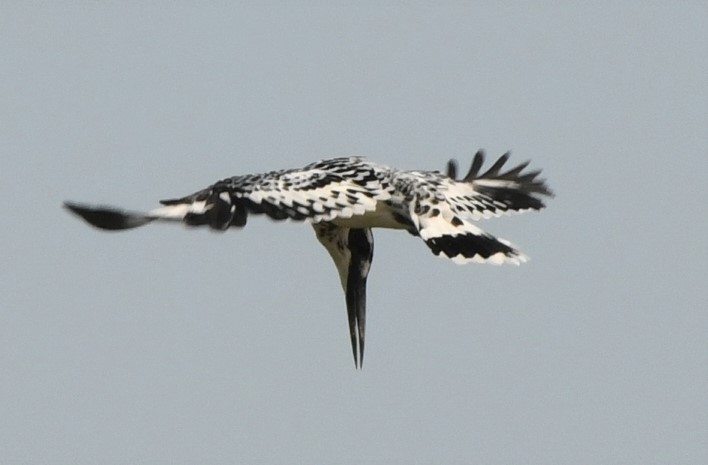
- White-breasted Kingfisher (Halcyon smyrnensis) 1 edge of ponds with tall coastal scrub, AQ, PHQ.
- White-throated Fantail (Rhipidura albicollis) 2 , vocal, very active in Casuarina woodland and scrub, often associated with other small, insectivorous birds in mixed species flocks, PHQ.
- Black Drongo (Dicrurus macrocercus) 1 solitary, conspicuous high perch in trees adjacent to coastal scrub and mangrove, AQ, MM (photo).

- Blackish Drongo (Dicrurus longicaudatus) 1 ID: paler than BLDR, edge of coastal scrub, PHQ.
- Chinese Long-tailed Shrike (Lanius schach) 12 solitary, frequently on conspicuous perch in open field and tall scrub; also edge of mangroves, ubiquitous (photo – see introductory text).
- Cinereous Tit (Parus cinereus) 2 vocal in mixed species flock with PALW and CHWE in casuarinas, PHQ.
- Yellow-bellied Prinia (Prinia flaviventris) 2 greg. in scrub at edge of road and mangrove, MM.
- Common Tailorbird (Orthotomus sutorius) 2 vocal, active in brushy areas, PHQ.
- Light-vented Bulbul (Pycnonotus sinensis) 1 on conspicuous perch, island garden, PHQ.
- Northern Sooty-headed Bulbul (Pycnonotus chrysorrhoides) 10 greg., vocal, ubiquitous in brushy areas and edge of mangroves (photo – see introductory text).
- Pallas’s Leaf Warbler (Phylloscopus proregulus) 4 vocal and extremely active in Casuarinas; a tiny, kinglet-like warbler (e.g. Regulus calendula spp.) appearance and behavior (photo).

- Dusky Warbler (Phylloscopus fuscatus) 1 foraging very low, nearly on the ground in shrubs around cafeteria dish washing area, PHQ (Note: In my opinion this odd little warbler has been misplaced within the genus Phylloscopus, based on its morphology and behavior. Perhaps it should be classified in a separate genus, e.g. Geophyllus).
- Chinese White-eye (Zosterops simplex) 1 vocal, highly active in mixed species flock with PALW and CITI in Casuarinas, PHQ.
- Great Myna (Acridotheres grandis) 2 on utility pole, greg. PHQ (photo).
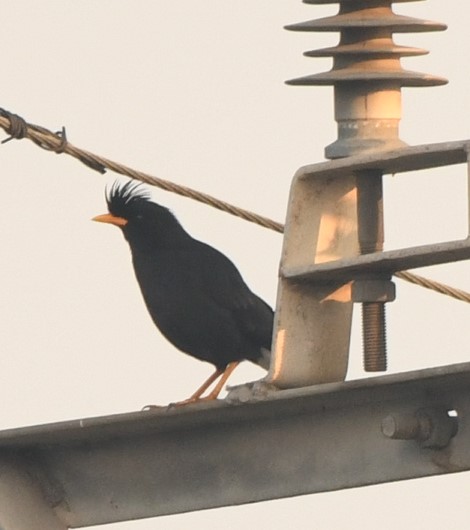
- White’s Thrush (Zoothera aurea) 3 solitary on paved walkways with leaf litter; most active and conspicuous early in the morning, PHQ (photo-see introductory text).
- Oriental Magpie Robin (Copsychus saularis) 1 (f) on side of levee near boat launch, MM.
- Orange-flanked Bush-robin (Tarsiger cyanurus) 1 (f) active on pathways with leaf litter, snatching-gleaning insects, PHQ (see introductory text).
- Daurian Redstart (Phoenicurus auroreus) 1 (f) on pavement and in shrubs adjacent to cafeteria dish washing area, PHQ.
- Japanese Stonechat (Saxicola stejnegeri) 3 solitary on exposed perches in coastal scrub along roadway, AQ, MM (photo).

- Eurasian Tree Sparrow (Passer montanus) 5 (m,f) vocal, greg. around buildings, PHQ.
- Chinese White Wagtail (Motacilla leucopis) 1 flew to roof top of gazebo next to pond, PHQ (photo).
